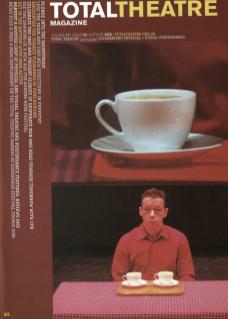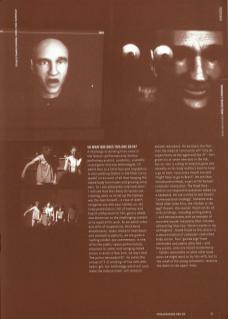What's theatre/performance for? What do we hate most about it? Where has it been, where is it now and where is it going? So much information, so much inspiration – where to start? CPR's Towards Tomorrow? was a five-day feast and this report can serve only as an hors d'oeuvres to whet the appetite. I hereby offer a few morsels that hopefully give something of the flavour of this seminal event, a little soupçon of the many reflections on the past, present and future of theatre/performance.
So what box does this one go in?
A challenge to dividing lines came in the lecture performance by Stelarc: performance artist, academic, scientific investigator and new technologist. I'll admit here to a little fear and trepidation in encountering Stelarc in the flesh (so to speak) on account of all that hanging the naked body from hooks and growing extra ears. So I was pleasantly surprised when I realised that the cheery Oz technician cracking jokes as he set up the laptops was the man himself – a case of didn't recognise you with your clothes on. His lively presentation, full of humour and boyish enthusiasm for life, gave a whole new dimension to the challenging content of so much of his work. As we watch video and stills of suspensions, third hand attachments, lasers linked to heartbeats and stomach sculptures, we are given a riveting insider-eye commentary: in one of his few public-space performances, attached to cables and swinging naked across a street in New York, we learn that ‘the police demanded ID'. He extols the virtues of 3D 'printing' of live cells with hydro-gel, bio-technology which will soon make the embryo/stem-cell research debate redundant. He bemoans the fact that the medical community will ‘only do experiments on the aged and the ill' – he's grown six or seven new ears in the lab, but no one is willing to help him grow one actually on his body and he's keen to have a go at eyes, nose and a mouth too and 'might have to go to Brazil'. We are then introduced to Head, a sort of CGI human/ computer interaction. The Head face-station can respond to questions asked via a keyboard. We are invited to test Head's 'conversational strategy'. Someone asks Head what came first, the chicken or the egg? Answer: the rooster. Head can do all sorts of things, including writing poetry – and demonstrates with an example of concrete/sound-led poetry that includes alliterating lines like: 'there's worms in my wellingtons'. Grand finale to the session is a demonstration of computer-controlled body action. Four ‘guinea pigs' have electrodes and cables attached – and hey presto, arms are raised involuntarily – Stelarc speculates on what other body parts we might want to try this with, but to the relief of the young volunteers, restricts the demo to the upper limbs.
J’accuse
We're here in the ‘courtroom' to witness theatre and performance facing the music – and we are invited to 'provoke, accuse and generally agitate the waters of discussion'. Today is the second day of Towards Tomorrow? – a five-day international gathering held at the Centre for Performance Research at the University of Wales, Aberystwyth on the occasion the thirtieth birthday of Cardiff Laboratory Theatre and CPR. Rather than navel gaze at their own achievements, CPR have generously opted to broaden the gaze to the furthest horizons – the past, present and future of theatre and performance. The five days include all sorts of events: performances, panels and debates, performative lectures, all-night talk-ins, a banquet – and this rather odd little number that we are eagerly anticipating.
This J'Accuse session is overseen by Philip Auslander the eminent writer, performance studies guru and cultural commentator (on everything from glam rock to performance and disability to robotics). We are told we have the opportunity to bring a charge and state our case (in no more than four minutes). The bewigged Justice Auslander is enthusiastically embracing his role as judge; the hammer comes crashing down with authority at regular intervals, objections are overruled and eventually the jury of twelve ‘good folk and true' are dismissed for apathy. All in all, it's a pretty good performance...
Protest, propaganda, manifestos, cries from the soul are all encouraged, but ‘ad hominem' attacks are proscribed – an early reference to Forced Entertainment sternly disallowed.
All sorts of accusations are made: supported or contested from the floor, verdicts returned.
J'Accuse: The theatre establishment are accused of erasing the voices of women from theatre history. The accuser cites a lengthy list of lauded playwrights and directors – male one and all.
J'Accuse: Theatre of the day is accused of appealing to the intellect rather than the heart and soul.
J'Accuse: British government agencies / arts organisations are accused of a failure to respond appropriately to campaigns that caused the closure of the Birmingham rep and the attempted censorship of Jerry Springer the Opera.
J'Accuse: Academy and artists alike are accused of a fear and loathing of the term 'theatre’, with a tendency to accord the term 'performance’ to anything that was interesting or which challenged the boundaries of theatre.
J'Accuse: That binary divides continue to confound – such as the divides between theory and practice, academic and artist.
J'Accuse: That the French philosophical mafia have a stranglehold on the conference.
J'Accuse: That performance studies are too English, too American, too Swedish, too Japanese – in other words, too tied to specific sites and national research agendas.
J'Accuse: That the previous two accusations are racist – and in any case, being rooted in one's own specific culture / geographic location informed the work one created – local knowledge being more important than generalisations.
The J'Accuse session was one of numerous colloquies, panels and discussion sessions which provided an opportunity for questions to be raised and responses expressed to what had been seen and heard throughout the very full five-day programme of performances, papers, presentations and provocations.
A concern felt particularly strongly by younger delegates, many of whom were students at Aberystwyth or invited to the conference as part of the Generation 24 panel of young practitioners, was that the conference was weighted too heavily towards the academic discipline of performance studies rather than reflecting actual artistic practice. This was an accusation that reverberated well beyond the J'Accuse session, and one that I felt some sympathy with – although it was rebuffed quite strongly by CPR's Richard Gough, who felt that those sorts of divides hardly existed.
But it must be said that although the performative lecture was a strong feature of the programme, and many performances were structured into the event, there were few opportunities to hear 'non-academic’ artists speak about their work and most of the presentations made were by interpreters of art rather than the makers themselves. A notable exception was Julian Maynard Smith of Station House Opera who gave a great presentation on his company's innovative work, which crosses divides of visual art and theatre in its ongoing investigation of the possibilities of site, scenography and the inter-relationship of video and live performance in works such as Bastille, Roadmetal Sweatbread and Live from Paradise.
But it was a positive sign that the opportunity for such criticism was built into the conference and there was no doubt that this international gathering was a very special event.
The amount of food for thought that was tasted, chewed over and digested was gargantuan. Here's a few titbits from the many sessions that I don't have the space to report on:
- The importance of pedagogy – what we teach and how we teach.
- The re-evaluation of the term 'community arts' to take in the notion that 'communities are those who have made themselves known', which includes communities of illness and dissent.
- The role of the audience – ‘to tell the story there has to be a receiver’.
- The use of the term 'mise en scene’ and how it might apply to live art practice and performance in public spaces.
- Nervousness versus safety - Enrique Pardo spoke of the importance of her ‘nervousness' in contrast to the 'cult of cool’.
- Patrice Pavis' presentation on the ‘reverse anthropology' of Mexican/American artist Guillermo Gomez-Pena in which he discussed the coming together of the 'Ethno' and 'Techno'.
One last word from writer Victoria Nelson, who urged 'enlightened awareness of the gaps – where we are all coming from’ – to which we could add ‘and where we are all going to’.
The Academic Performs (Or is that the Performer Academes?)
A strong feature of Towards Tomorrow? were the lecture-performances that challenged that 'binary divide’ between academic theory and performance practice. One of these was called ‘A Constant State of Research’, performed by Kristine Nutting, who presented an academic 'self' who gave the lie to the bluestocking-bimbo divide (pages torn from books; photocopied hand-outs stuffed into panties; key lines of text scrawled on thighs). With the aid of some wonderfully bad puppetry (Derrida and Lacan as arguing hand-puppets and a Barbie and Ken exploration of ‘masculinist' and ‘feminist' theatre), she raced through the feminist performance studies canon – from Cixous’ ‘if the stage were a woman, that would mean ridding it of theatricality’ to Finlay's 'theatre of the womb' to Britney Spears as the modern Ophelia... And yes – she got her tits out for the gals, a riposte to previously experienced disapproval within the American Academy: 'there's titties on the stage... she can write about them, talk about them – but not show them?’ She ends bound and gagged with the words of Julia Kristeva playing on tape. ‘I am just pornography parading around as art!’
The Commentator Informs – A Whiz Bang Crash Through Thirty Years of Performance
Boundaries between artforms and practices were seen in a presentation by Bonnie Marranca, co-founder/editor of Performing Arts Journal, to have been breaking down for many decades. She gave us a great Cook's Tour of three decades of the Journal's coverage of the American experimental theatre/performance scene – from Wilson and Foreman's 'Theatre of Images' to the shift (which she described as 'driven by women artists') from the impersonal to the autobiographical, and the artforms of dance, music and videoart fused into new performance hybrids – citing the work of Meredith Monk, Trisha Brown and Laurie Anderson. She went on to tackle the questions: when does a performance become unwatchable? Raising the controversy around Bill T. Jones’ use of images of AIDS patients (dubbed ‘victim art' by some commentators), the growth of 'body art' and increasing use of self-mutilation. Just one hour – but she whizzed through the development of work that was intertextual, intercultural, intermedia; performance as ontology and the breakdown of life/art and audience/performer boundaries; sexuality in performance as liberating act versus buying into the oppression of women, performance in cyberspace and the discourse around new media; the return to a stripped-down art and the re-emerging of spirituality. Her final statement offered a challenge to contemporary artists: '[theatre/performance] works need to dramatise not just document human behaviour’.
To find out about this and future CPR projects, see www.thecpr.org.uk



